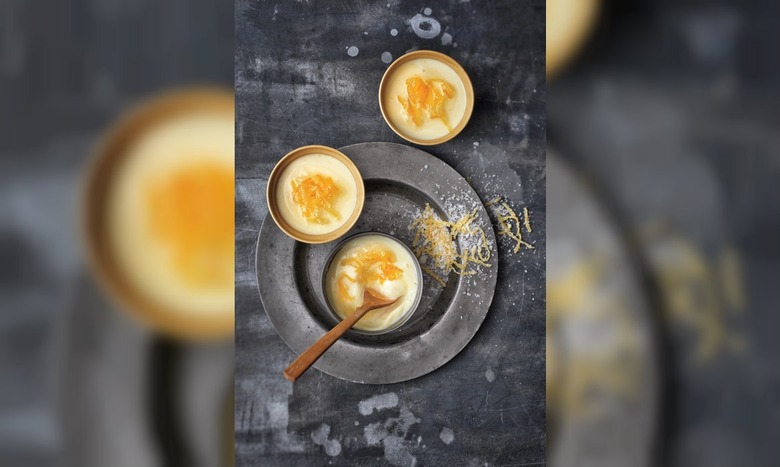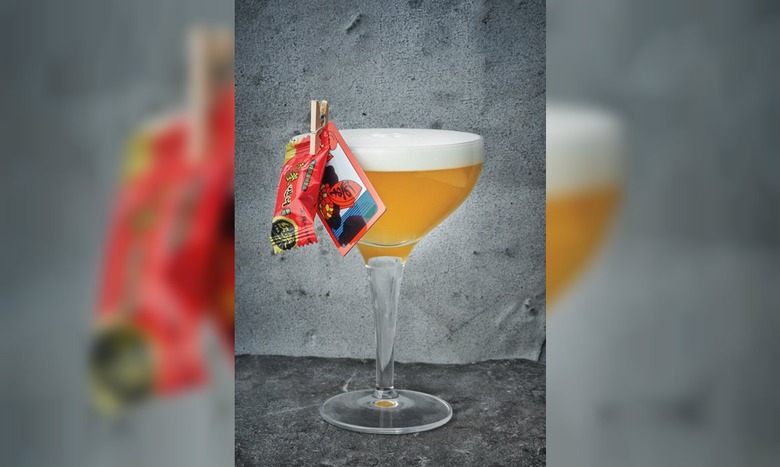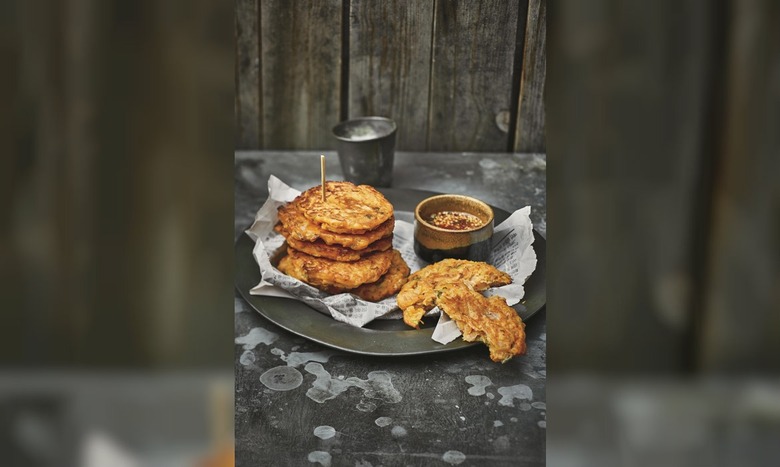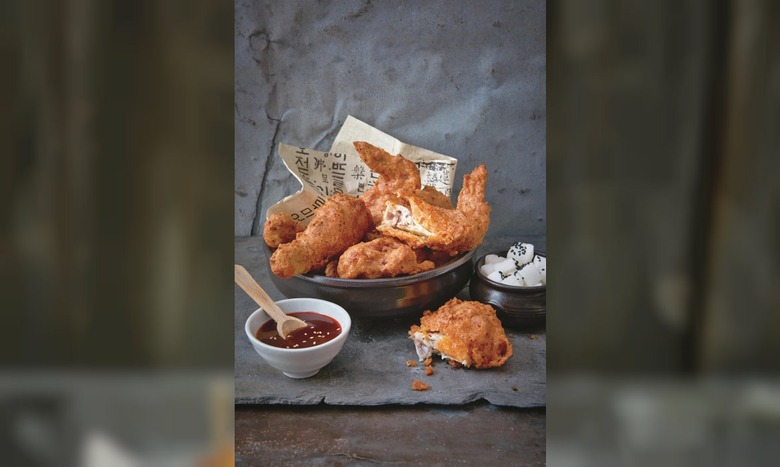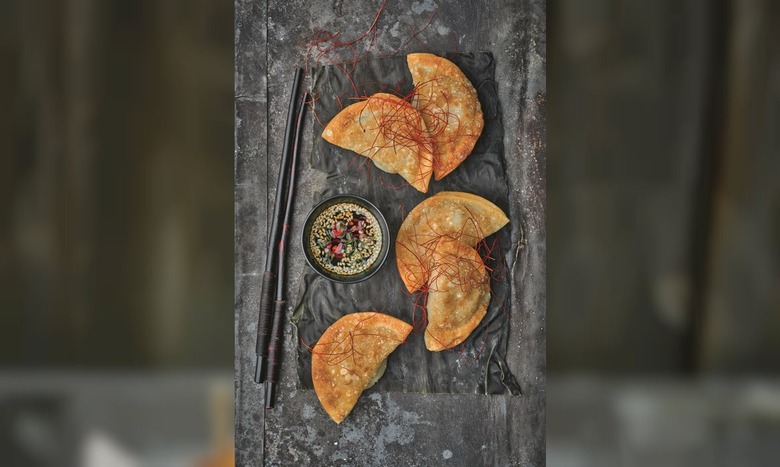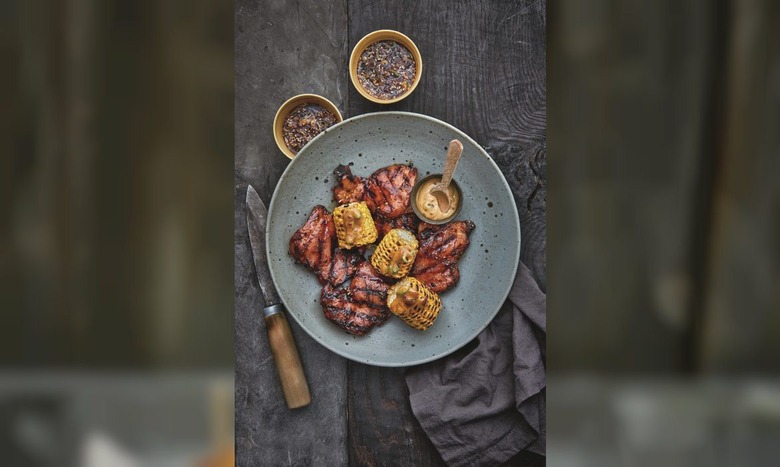Judy Joo Shares Her Take On Korean Food In Her Cookbook 'Korean Food Made Simple'
We may receive a commission on purchases made from links.
In Judy Joo's first cookbook, Korean Food Made Simple, the now cooking show host, Iron Chef, and executive chef shares easy-to-make Korean recipes influenced by a lifetime of disco fries in New Jersey, matzo ball soup in New York, and, of course, gochujang at home.
Both of Joo's parents immigrated to the U.S. from Korea, where they met and married. Joo herself grew up in Summit, New Jersey, attended college in the Midwest at Ohio State University, and then returned to New York to work on Wall Street. Her cookbook and recipes are sprinkled with breadcrumbs that tell of the now self-professed "French-trained Korean American Londoner." Recipes, like her Spicy Pork Belly Cheesesteak, one of her favorite comfort foods, and her Ultimate KFC (Korean Fried Chicken) recipe, almost tip their hat to her dual identity as a Korean and an American.
Just as the book's title promises, Joo actually makes Korean food, which doesn't often derive the same attention as other Asian cuisines familiar and simple. This book is filled with fusion-style recipes, but also stays true to the basic pillars of traditional Korean food.
We had the opportunity to speak with Joo about her new book, her philosophy on cooking, and how she hopes readers will use her book:
The Daily Meal: What is your general philosophy on cooking?
Judy Joo: I cook food that is comforting and cozy. It's food that you could eat every day and hugs you back. Food is a language of love for me. Feeding people is a way to nourish body and soul and show people that you care.
How did it inspire the recipes you chose to include in this book?
My recipes are all very welcoming and approachable. My recipes reflect my food philosophy about warmth and love. I also believe very much in balance, so there are a great variety of recipes. Sometimes you feel like eating a zen tofu salad. Some days you feel like fried chicken!
What are some of your favorite Korean dishes to cook at home?
I love making a hot tofu soup called Soon Dubu Jiggae. I love seafood and spicy homey dishes — this stew hits all of the right buttons for me! I eat it with a steaming bowl of rice and I feel happy!
I also have a guilty pleasure — my ultimate lazy food is instant ramen noodles. I do pimp them out though with lots of veggies, egg, anything that is in my fridge...
It takes 10 minutes to put together and voila — I have a hot, addictive, wonderfully slurping bowl of noodles.
In the introduction to the book you call yourself a "French-trained Korean American Londoner." How does that influence the food you seek out, and perhaps more importantly the way you approach cooking food and Korean food?
The recipes are inspired by my global citizen-type lifestyle and background. I grew up in America with Korean parents and have been living in Europe for 10 years. I have strong anchors in three continents. My recipes reflect my international upbringing and inspiration from my travels. I use a lot of Korean flavors melded with Western techniques, and you'll see this throughout my book. I even have a chapter on bread — Korean flavors meld beautifully with boulangerie.
What does "Korean Food Made Simple" mean to you (i.e. ingredients choices, cooking techniques)?
Ease of ingredients and cooking techniques. All of the recipes are very doable and designed for the home cook to be able to handle.
How do you break down this cuisine, which is so familiar to you, for the novice, non-Korean home cook?
It is all about understanding the flavors first and foremost. Try all of the ingredients on their own first to get an idea of the flavor profile. Then just taste and taste all throughout the recipe. Korean cuisine generally has someone spicy, sweet, salty, and bitter all mixed together for balance. But, don't be afraid to add more or less of certain things according to your palate, whether it is more spice or less, more garlic or less, etc. Just be open to be big bold flavors and cook with confidence.
How do you hope readers will use this book?
I really hope readers will try new recipes that they would normally not have cooked at home and jazz up family dinner with some Korean style!
What is the ultimate take-away from this book?
A few Korean flavors and ingredients can transform a meal into something extraordinary and exciting.
Is there anything else you would like to share about this book?
Every single recipe was literally cooked by me and Vivian Jao together. We tested and tested and Vivian used to be the director of the kitchens at Saveur magazine, so the recipes also have her meticulous eye behind them all. One night after cooking for 16 hours for a few days straight, we got a Thai foot masseuse to come over to rub our swollen feet and legs. We were in so much aching pain! It was a lot of hard work and I hope this effort shines through.
Want to try a recipe?
Citron Tea Posset
Unless you're familiar with British cuisine, you may not have heard of the dessert posset. The best way to describe it is a cream-based lemon pudding. I top it with thinned citron tea syrup (yujacha), which is made from the Asian citrus fruit, yuja (in Japanese it is called yuzu), and has a delightful floral fragrance and bitter-lemon marmalade-like flavor that cuts through the sweetness of the posset really well. I like to zest the lemon on a Microplane so it's very fine. If your tool results in larger bits of zest, you may wish to pass the flavored cream mixture through a fine-mesh strainer before pouring it into serving glasses. — Judy Joo
The Psy Sour
Look for Korean ginseng drink with honey in Korean markets. It usually comes in small clear bottles; the most popular brand is Royal King. If you cannot find it, honey syrup (right) is a good substitute. Yuja, an Asian citron fruit, is called yuzu in Japanese and is available at Japanese markets. Lemon juice will do in a pinch. We serve ours with a ginseng candy and a traditional Hwatu playing card. — Judy Joo
Kimchi Pancakes
There's something to be said for eating kimchi when it's young and fresh and still a little crisp. But when your kimchi gets really funky and fermented and you're scared of what it might do to your digestive system, that's the best time to make these pancakes. That's when the kimchi flavor really shine through. These pancakes are really tasty with their crispy outside and are so easy to make.
These are usually made as large pancakes that are cut into smaller pieces to be shared at the table, but I find smaller ones more attractive and easier to flip. — Judy Joo
Ultimate KFC (Korean Fried Chicken)
I have always loved fried chicken. But even though I grew up eating it in America, for me "KFC," stands for Korean fried chicken. There are many different versions, but what they all have in common is a very thin, hard crisp coating, which comes from using potato starch or cornstarch instead of flour, as well as double frying. My take on the dish, which includes vodka and matzo meal, is a little unorthodox and has a fair number of ingredients, but I call it "ultimate" for a reason. Two things make it even better: its customary accompaniment of cubed pickled radish and ice-cold beer. — Judy Joo
Meaty Dumplings
My mom used to enslave my sister and me to make these by the thousands. Plump dumplings neatly lined up on plates and trays covered every surface of the kitchen. I used to only eat the skins, shaking out the meaty insides for my sister. As I got older, I learned to savor those juicy gems as well, but the crispy skins are still my favorite part. If you prefer, the dumplings can be steamed instead of fried. These are a best seller at my restaurant, Jinjuu. — Judy Joo
Mom’s BBQ Chicken
My mom's BBQ chicken is the stuff of legend. She even used to grill it in our garage in unfavorable weather. I remember sitting on the steps staring at the little grill, watching her flip pieces of the juicy ginger-and-sesame-marinated chicken with chopsticks, and smelling the sweet smoke. Even your Korean-food-doubter friends will gladly chow down on this. — Judy Joo
For the Mom's BBQ Chicken recipe, click here.
Angela Carlos is the Cook Editor at The Daily Meal. Find her on Twitter and tweet @angelaccarlos.
